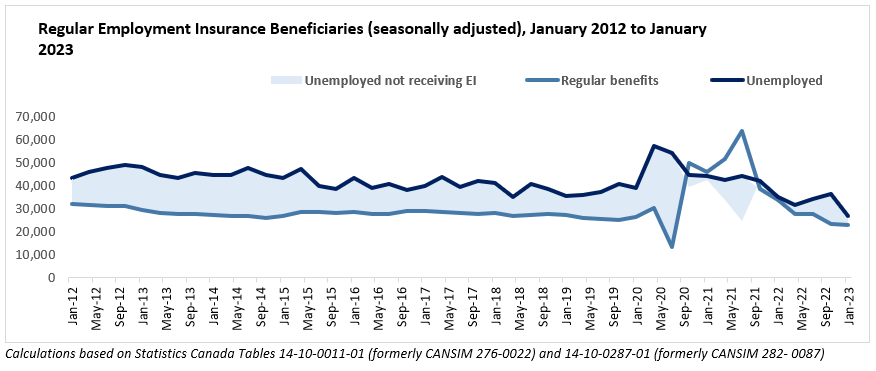Unemployment Rate by Province
Nova Scotia’s unemployment rate rose from 7.4% in 2019 to 9.8% in 2020 due to the economic impacts of the COVID-19 pandemic. In 2021, it declined to 8.4% as the province’s economy recovered. It continued declining in 2022 and reached 6.4%.
- Nova Scotia had the lowest unemployment rate in Atlantic Canada in 2021 and in 2022, even though it was higher than for the rest of the provinces.
- The unemployment rate in Nova Scotia continued to be higher for males than females in 2022.
- Male unemployment was 7.3% in 2022 down from 9.7% in 2021, which the lowest unemployment rate for males in the past 10 years.
- Female unemployment was 5.7% in 2022 and it also was the lowest unemployment rate for females since 2012.
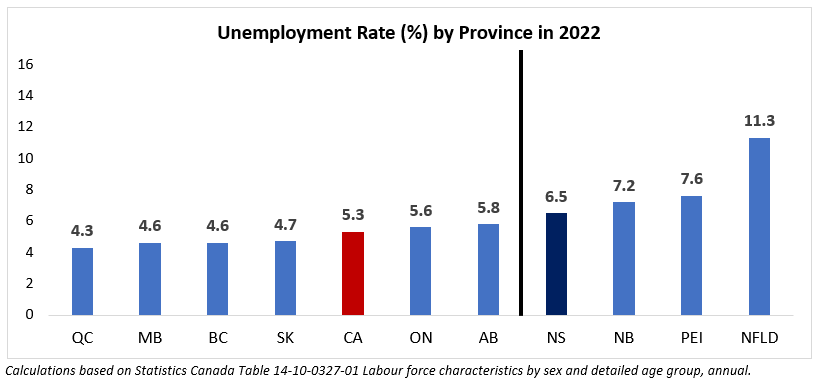
Age Groups
In 2022, youth (ages 15 to 24) labour force increased by +300 (+0.45%), while youth unemployment rate fell to 11.5%, from 14.2% in 2021 – the lowest since 2012. Male youth unemployment rate at 13.1% was higher than female youth unemployment rate at 10%, even though both are down from 2021 and both are the lowest since 2012 for both sexes in this age group.
In 2022, core age workers (25 to 54) in the labour force increased by +5,400 (or +1.7%) to 316,700 since 2021, while their unemployment rate fell to 5.2% in 2022 from 7.1% in 2021. Male unemployment rate in this age group stood at 6.2%, while the female unemployment rate was 4.2%.
Labour force 55+ years of age increased +1,100 or +0.9% since 2021, while its unemployment rate fell to 6.7% in 2022 from 8.8% in 2021.
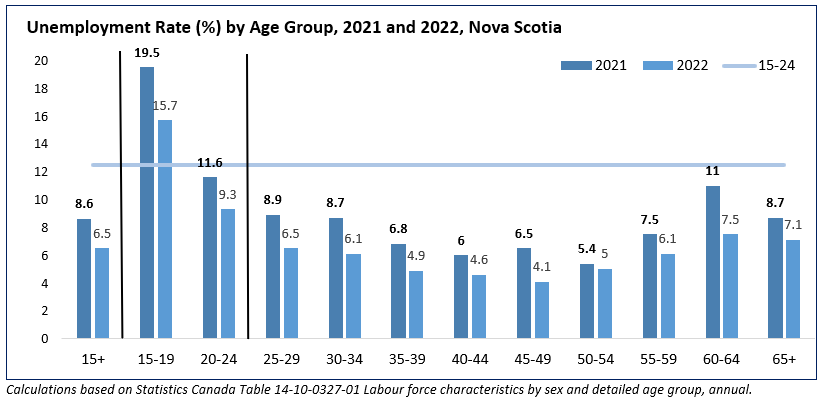
- In Nova Scotia, and Canada, youth (ages 15 to 24 years) tend to have the highest unemployment rates relative to other age groups. The economic recovery in 2021 led to a decline in the unemployment rate for those aged 15 to 24 from 17.2% in 2020, to 13.5% in 2021, which continued in 2022 to 11.5%.
- Job gains were also seen among older workers (65+), as their employment level rose by +1,000 (+3.8%) in 2022. The number of unemployed in this age group was essentially unchanged year-over-year, however unemployment rate in 2022 for this age group was down to 7.1%.
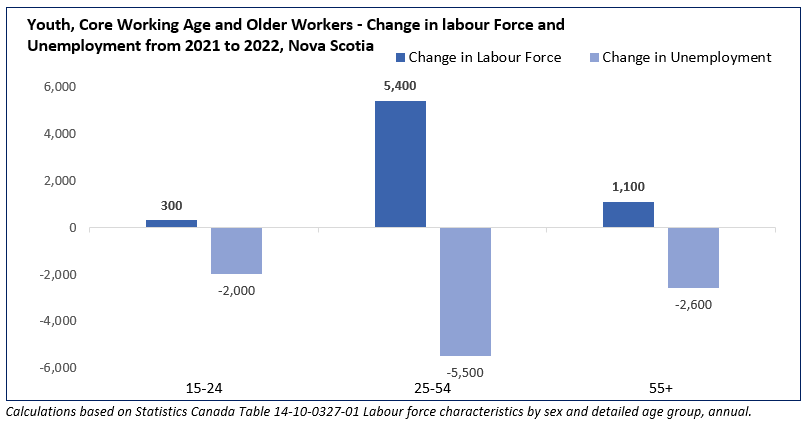
Location of Study
- In Nova Scotia, those with a postsecondary education (PSE) had a lower unemployment rate in 2021, than the provincial unemployment rate. Unemployment rates differ across different types of postsecondary education and according to where the PSE credential was obtained.
- Overall, those with a postsecondary education credential obtained in Nova Scotia had a higher unemployment rate than those who obtained their PSE outside Nova Scotia. This trend is influenced by those who had an apprenticeship or trades certificate or diploma.
- PSE credentials below a bachelor’s level degree that were obtained in another province had higher unemployment rates than credentials obtained in Nova Scotia. However, PSE credentials higher than a bachelor level degree obtained in Nova Scotia had higher unemployment rates.
- The largest positive difference in unemployment rates between PSE credentials obtained in and outside Nova Scotia was between those with a degree in medicine, dentistry, veterinary medicine or optometry obtained outside of NS. Generally, this means in 2011, finding a job was easier for those who obtained a degree in medicine, dentistry, veterinary medicine or optometry in Nova Scotia compared to those that obtained it outside Nova Scotia
- On the other hand, Trades certificate or diploma other than Certificate of Apprenticeship obtained in the province made it easier generally for those who obtained either in Nova Scotia to find a job in Nova Scotia. This differs than the situation in 2016 when unemployment rate for those with noncertified trade obtained in Nova Scotia was higher than for those who obtained it outside of the province.
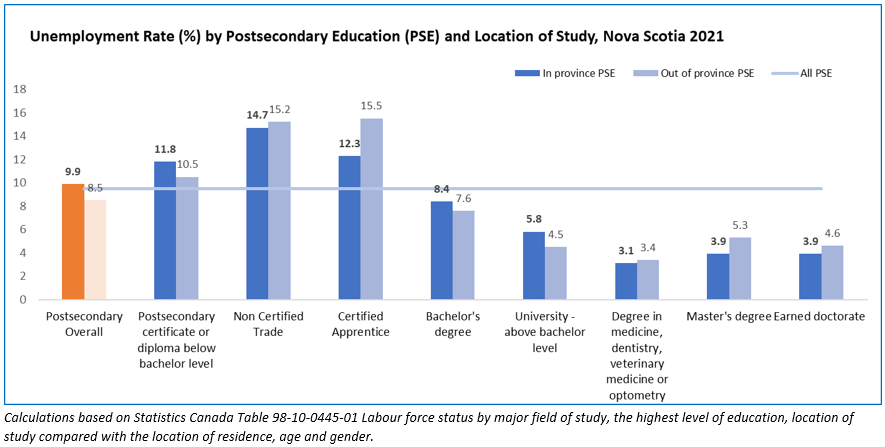
Employment Insurance
The seasonally adjusted number of Nova Scotians receiving regular Employment Insurance (EI) benefits trended downward between January 2012 and February 2020. It spiked from October 2022 to September 2021 and then went down from January 2022 onwards (including January 2023).
- The arrival of the COVID-19 pandemic in Nova Scotia resulted in unprecedented effects on the number of unemployed and those receiving EI. Workers that were unemployed between March 15th and October 3rd, 2020 were able to claim the Canadian Emergency Response Benefit (CERB) – which provided temporary financial assistance.
- In the spring and summer of 2020, the difference between the number of unemployed and the number of EI beneficiaries expanded, as the number of unemployed rose and the number of EI beneficiaries declined due to many applicants being redirected to the CERB program.
- As the CERB program was wound down in the fall of 2020, the criteria to claim EI was temporarily reduced to include workers not eligible in the past, such as students, youth, and occasional workers. This was done to transition CERB recipients to EI. As a result, the number of EI beneficiaries was, unusually, higher than the number of unemployed workers from October 2020 through September 2021.
- The number of unemployed overtook the number of EI recipients once again in October through December of 2021, as the temporary eligibility enhancements to EI ended. By January 2022, the number of seasonally adjusted EI recipients fell to 31,320 – approaching historical norms. This trend continued to present time, including January 2023.
